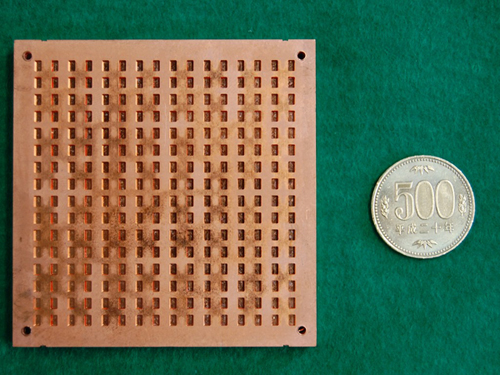There are increasing demands to use high frequencies of around 60GHz for wireless communications with high data transmission rates of around 10Gbps.
At such high frequencies, propagation loss in air is so great that high-gain antennas with more than 30dBi gain are required for point-to-point wireless communication over distances of a few kilometers.
Makoto Ando and his team from the department of electrical and electronic engineering at Tokyo Institute of Technology have developed a double-layer corporate-feed hollow-waveguide slot array antenna. The structure is fabricated by diffusion bonding of laminated metal thin plates. Etching the plates allows high precision of about 20µm and the diffusion bonding gives perfect electrical contact. A corporate-feed circuit is placed on the bottom layer while radiating slots are placed on the top layer.
Yohei Miura and colleagues designed a 16×16-slot array antenna for uniform excitation. They connected a 6mm thick plate to the bottom of the antenna to take measurements. A 60GHz-band 70mm-square antenna consisting of 10 laminated plates each 0.3mm thick achieved an antenna efficiency of about 80%, including 0.3dB conductor loss, with more than 32dBi gain over an 8% bandwidth.
The performance of this antenna can also be extended for high-frequency operation up to the 350GHz band, circular polarization and sidelobe suppression. It could be a candidate for replacing parabolic antennas in millimeter-wave-band applications.
Reference
- Authors: Yohei Miura1, 2, Jiro Hirokawa1, Makoto Ando1, Yuzo Shibuya2, and Goro Yoshida2
- Title of original paper: Double-layer full-corporate-feed hollow-waveguide slot array antenna in the 60 GHz-band
- Journal, volume, pages and year: IEEE Transactions on Antennas and Propagation, 59 (8), 2844-2851 (2011)
- Digital Object Identifier (DOI): 10.1109/TAP.2011.2158784
- Affiliations: 1 Department of Electrical and Electronic Engineering, Tokyo Institute of Technology, 2 Development Department, Research & Development Center, Japan Radio Co., Ltd
- Department website:http://www.ee.titech.ac.jp/english/


A waveguide slot array antenna fabricated by diffusion bonding of laminated copper thin plates.
. Any information published on this site will be valid in relation to Science Tokyo.



